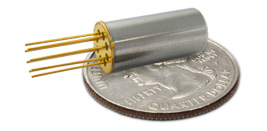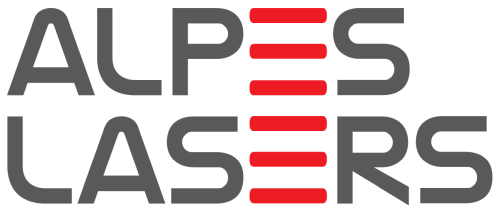external-cavity diode lasers (original) (raw)
Acronym: ECDL
Definition: non-monolithic diode lasers where the laser cavity (resonator) is completed with external optical elements
Categories:  optoelectronics,
optoelectronics,  laser devices and laser physics
laser devices and laser physics
- semiconductor lasers
- diode lasers
* high-brightness laser diodes
* diode bars
* diode stacks
* vertical cavity surface-emitting lasers
* external-cavity diode lasers
* fiber-coupled diode lasers
* mode-locked diode lasers
* laser diode modules
* direct diode lasers
* (more topics)
- diode lasers
Related: diode laserslaser diodesmode-locked diode laserssemiconductor laserswavelength tuninglinewidthmode-locked lasersdistributed Bragg reflector lasersvertical external-cavity surface-emitting lasers
Page views in 12 months: 7206
DOI: 10.61835/te0 Cite the article: BibTex BibLaTex plain textHTML Link to this page! LinkedIn
Content quality and neutrality are maintained according to our editorial policy.
📦 For purchasing external-cavity diode lasers, use the RP Photonics Buyer's Guide — an expert-curated directory for finding all relevant suppliers, which also offers advanced purchasing assistance.
Contents
What are External-cavity Diode Lasers?
An external-cavity diode laser is a diode laser based on a laser diode chip integrated into a somewhat larger laser cavity that also contains other optical elements. The diode chip is typically antireflection coated at one end, and the laser resonator is completed with e.g. a collimating lens (or separate fast-axis and slow-axis beam collimators) and an external mirror, as shown in Figure 1.
Another type of external-cavity laser uses a resonator based on an optical fiber rather than free-space optics. Narrowband optical feedback can then be provided by a fiber Bragg grating.
Possible Features
The external laser resonator introduces several new features and options:
- An optical bandpass filter can be used to determine the emission wavelength and to reduce the emission linewidth. A diffraction grating or a volume Bragg grating (VBG, also called VHG = Volume Holographic Grating) can be used to obtain a fixed wavelength narrow-linewidth laser.
- Wavelength tuning is possible by incorporating an adjustable optical bandpass filter as a tuning element. Most often a diffraction grating is used. (See below for details.) Another possibility is to use a wavelength selector with a somewhat larger bandwidth and tune the emission wavelength within its range, e.g. by varying the drive current of the laser diode.

Figure 1: Simple setup of a diode laser with external cavity. The semiconductor chip is anti-reflection coated on one side, and the laser resonator extends to the output coupler mirror on the right-hand side.
- Compared to a standard laser diode, the longer resonator increases the damping time of the intracavity light, allowing for lower phase noise and a smaller emission linewidth (in single-frequency operation). An intracavity filter such as a diffraction grating can further reduce the linewidth. Typical linewidths of external cavity diode lasers are below 1 MHz.
- The external cavity also adds important features for mode locking (see below).
External-cavity diode lasers can be fabricated with very compact setups. Depending on the additional optical elements required, it is often possible to make miniature lasers of this type.
Note that there are external-cavity semiconductor lasers that are not diode lasers: optically pumped vertical external-cavity surface-emitting lasers (VECSELs), which do not contain a p–n junction.
Tunable External-cavity Diode Lasers
Tunable external-cavity diode lasers (→ tunable lasers) typically use a diffraction grating as the wavelength-selective element in the external cavity. They are also called grating-stabilized diode lasers.
The common Littrow configuration (see Figure 2a) contains a collimating lens and a diffraction grating as the end mirror. The first-order diffracted beam provides optical feedback to the laser diode chip, which has an anti-reflection coating on the right side. The emission wavelength can be tuned by rotating the diffraction grating. A disadvantage is that this also changes the direction of the output beam, which is inconvenient for many applications. (Alternatively, one can rotate the assembly with the diode chip and lens.)

Figure 2: Tunable external-cavity diode lasers in Littrow and Littman–Metcalf configurations.
In the Littman–Metcalf configuration ([3], Figure 2b), the grating orientation is fixed and an additional mirror is used to reflect the first-order beam back to the laser diode. The wavelength can be tuned by rotating this mirror. This configuration provides a fixed output beam direction and also tends to have a narrower linewidth because the wavelength selectivity is greater. (Wavelength-dependent diffraction occurs twice instead of once per resonator revolution.) A disadvantage is that the zero-order reflection of the beam reflected by the tuning mirror is lost, so the output power is lower than that of a Littrow laser. Competing types of tunable lasers are DBR laser diodes and small fiber lasers.
Mode-locked External-cavity Diode Lasers
In the context of mode locking (→ mode-locked diode lasers), external cavity diode lasers have several interesting properties:
- Additional optical elements, such as a saturable absorber for passive mode locking or an optical filter, can be inserted into the laser resonator.
- The longer laser resonator allows for a lower pulse repetition rate (although usually still above 1 GHz), and also for tuning the repetition rate by changing the resonator length.
- Even for high repetition rates of tens of gigahertz, external-cavity lasers, then operated with harmonic mode locking, can be interesting because they exhibit lower laser noise, e.g. in the form of timing jitter.
More details can be found in the article about mode-locked diode lasers.
Mode-locked external-cavity diode lasers sometimes compete with mode-locked fiber lasers. They do not share their potential for high output powers, but are much more compact and much cheaper to manufacture.
Applications
Mode-locked ECDLs are mostly used in data transmitters for optical communications. Tunable devices find applications in areas such as laser absorption spectroscopy of trace gases.
Frequently Asked Questions
What is an external-cavity diode laser (ECDL)?
An external-cavity diode laser is a laser built around a semiconductor laser diode chip that is integrated into a larger laser resonator, which also contains external optical elements like lenses and a mirror or grating.
What are the main advantages of an external-cavity design for a diode laser?
The external cavity allows for precise control of the emission wavelength, achieving a much narrower emission linewidth and lower phase noise. It also allows for inserting additional components for purposes like mode locking.
Why do external-cavity diode lasers have a narrow linewidth?
Their longer laser resonator increases the damping time of the intracavity light, which leads to lower phase noise. An intracavity optical filter, such as a diffraction grating, can further narrow the linewidth.
What is the difference between the Littrow and Littman–Metcalf configurations?
They are two common designs for tunable ECDLs. The Littrow design tunes the wavelength by rotating a diffraction grating, which also changes the output beam's direction. The Littman–Metcalf design uses a fixed grating and a rotating mirror, providing a fixed output beam direction.
What are typical applications of external-cavity diode lasers?
Tunable devices are frequently used in areas like laser absorption spectroscopy for trace gas sensing, while mode-locked versions are used in optical data transmitters for telecommunications.
Suppliers
Sponsored content: The RP Photonics Buyer's Guide contains 24 suppliers for external-cavity diode lasers. Among them:
⚙ hardware
Serving North America, RPMC Lasers offers narrow linewidth external cavity Volume Bragg Grating (VBG) and Fiber Bragg Grating (FBG) wavelengths in the red, NIR, and SWIR spectral regions from approximately 633 nm to 1665 nm, eliminating wavelength drift and providing exceptionally high spectral purity with multiple output power options available for most wavelengths.
Our innovative VBG & FBG structures achieve narrow linewidth and consistent wavelength output, ensuring effective wavelength control even with changing temperature and aging, while delivering high-quality output with low noise driven by VBG technology.
Customizable, compact designs come in TO-can, butterfly, and other fiber-coupled component and OEM packages, with lightweight, robust, hermetically sealed options and optional fiber coupling for long-term reliability and ease of integration in sensing and telecom applications.
Let RPMC help you find the right laser today!
⚙ hardware
The Micron laser is a mode-hop free tunable external cavity laser for output powers of up to 300 mW. Versions with emission wavelengths between 638 nm and 1700 nm are available.
⚙ hardware
Alpes Lasers offers mid-IR external cavity lasers with wavelengths spanning 4.3 to 14 μm. External cavity kits with integrated laser control electronics are also available. These are Fabry–Pérot lasers designed for maximum width of the gain profile.
⚙ hardware
Gain Chips are modified Fabry–Pérot laser diodes with an excellent AR coated output facet. While not self-lasing they are intended to be operated in External Cavity Diode Laser setups (ECDL), such as in Littman or Littrow configuration. With external feedback they reveal narrow single frequency operation in combination with superior tuning capabilities.
⚙ hardware
TOPTICA offers ECDLs with unique tuning capabilities. The CTL lasers tune up to 110 nm without any mode hop. Finding resonances of quantum dots or micro resonators as well as spectroscopy has never been easier. TOPTICA continues to provide the DL pro, which is now available at even more wavelengths and is well suited for laser cooling and many other AMO experiments.
⚙ hardware
The Stretto is a high precision tunable external-cavity diode laser, available for narrow linewidth emission from ultraviolet to infrared. Being designed for seamless OEM integration and efficient volume production scaling, Stretto is a go-to laser solution for industries requiring high precision and reliability.
Bibliography
| [1] | H. Edmonds and A. Smith, “Second-harmonic generation with the GaAs laser”, IEEE J. Quantum Electron. 6 (6), 356 (1970); doi:10.1109/JQE.1970.1076460 |
|---|---|
| [2] | M. G. Littman and H. J. Metcalf, “Spectrally narrow pulsed dye laser without beam expander”, Appl. Opt. 17 (14), 2224 (1978); doi:10.1364/AO.17.002224 |
| [3] | K. Liu and M. G. Littman, “Novel geometry for single-mode scanning of tunable lasers”, Opt. Lett. 6 (3), 117 (1981); doi:10.1364/OL.6.000117 |
| [4] | M. Fleming and A. Mooradian, “Spectral characteristics of external-cavity controlled semiconductor lasers”, IEEE J. Quantum Electron. 17 (1), 44 (1981); doi:10.1109/JQE.1981.1070634 |
| [5] | C. J. Hawthorn et al., “Littrow configuration tunable external cavity diode laser with fixed direction output beam”, Rev. Sci. Instrum. 72 (12), 4477 (2001); doi:10.1063/1.1419217 |
| [6] | P. Zorabedian, “Tunable external-cavity semiconductor lasers”, in F. J. Duarte (ed.), Tunable Lasers, p. 349 (Academic Press, London, 1995) |
(Suggest additional literature!)
Questions and Comments from Users
Here you can submit questions and comments. As far as they get accepted by the author, they will appear above this paragraph together with the author’s answer. The author will decide on acceptance based on certain criteria. Essentially, the issue must be of sufficiently broad interest.
Please do not enter personal data here. (See also our privacy declaration.) If you wish to receive personal feedback or consultancy from the author, please contact him, e.g. via e-mail.
By submitting the information, you give your consent to the potential publication of your inputs on our website according to our rules. (If you later retract your consent, we will delete those inputs.) As your inputs are first reviewed by the author, they may be published with some delay.











